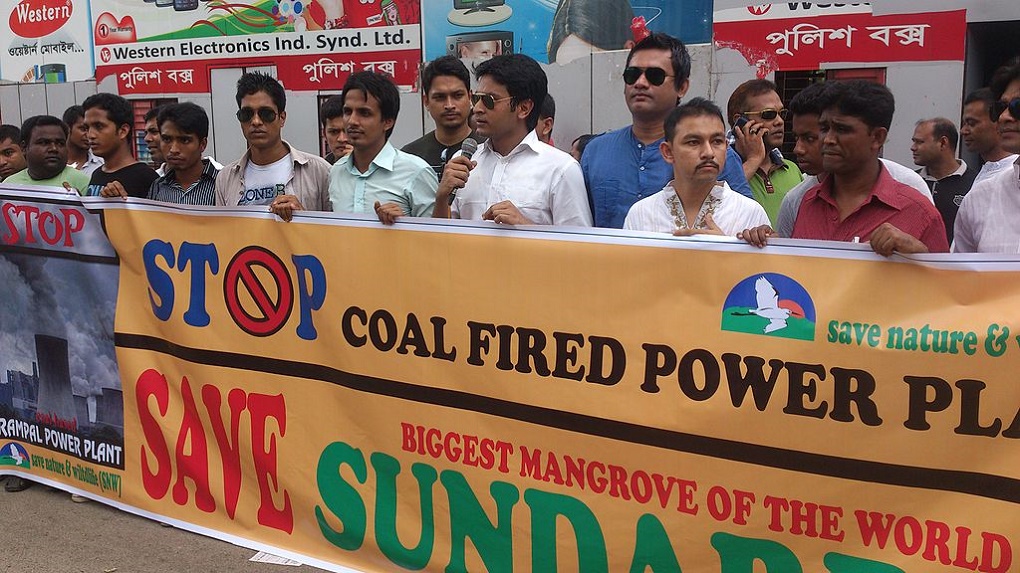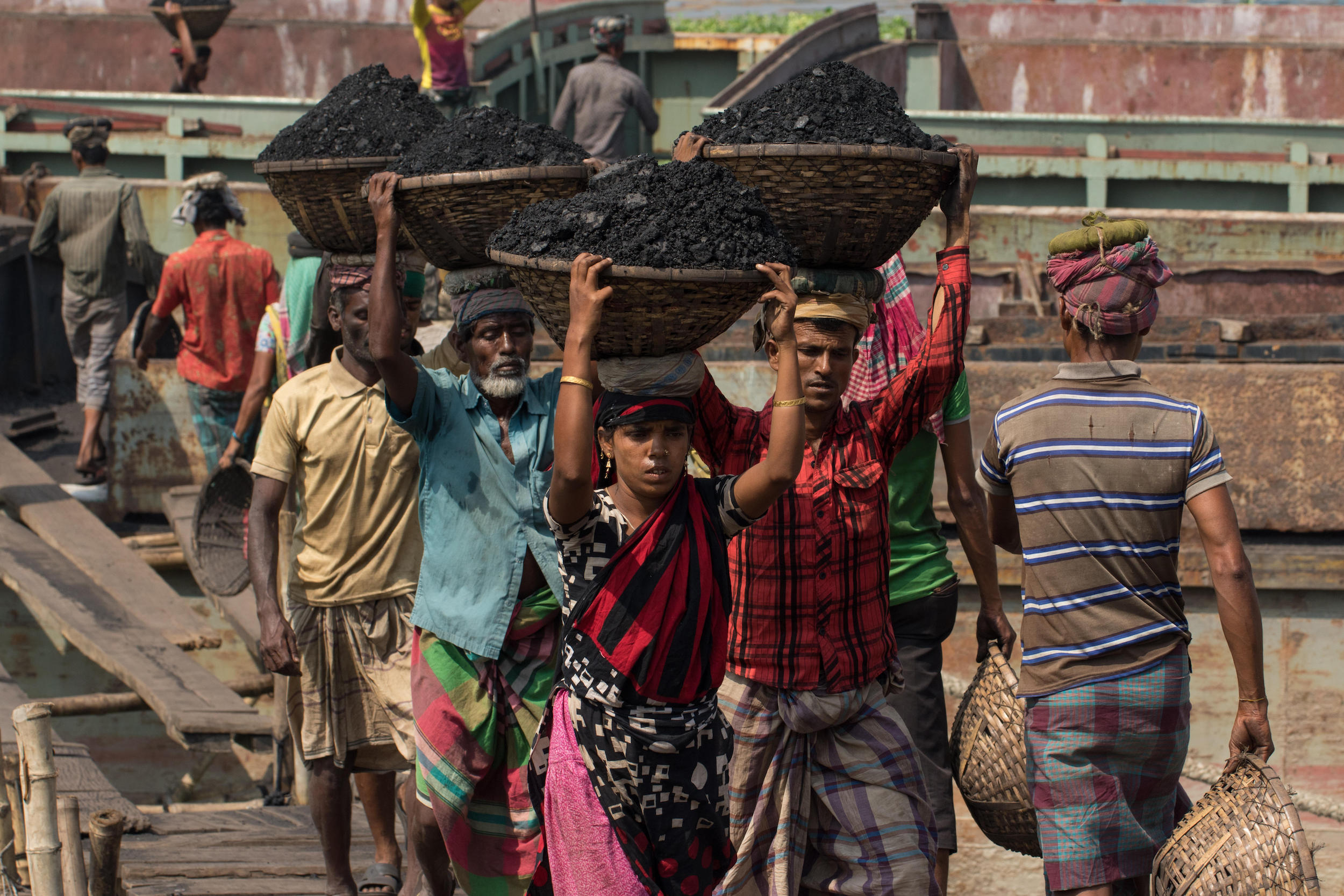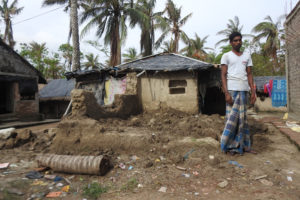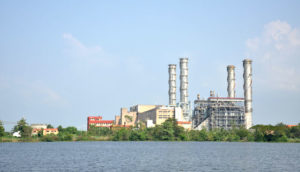Bangladesh will retreat from coal power if a recent proposal is approved by Prime Minister Sheikh Hasina.
In August, the Ministry of Power, Energy and Mineral Resources sent a letter to the Prime Minister’s Office. The letter, which The Third Pole has seen, seeks approval to convert 13 coal-fired power plants, which are currently in the pipeline, into liquefied natural gas (LNG)-based plants.
The previous month, Nasrul Hamid, Bangladesh’s minister of power, energy and mineral resources, said during a webinar that the country intended to “review” all but three of 29 planned coal plants that had been granted a licence. Of the 29, work on 18 is underway. The letter proposes that five of these 18 be completed as coal-fired plants.
This leaves 11 projects that have a licence, but have not been started. Officials told The Third Pole that these are sitting idle for the time being, and that the government might gradually cancel their approval.
The main issue, according to the letter, is the inability to finance the coal-fired plants.
In July, Hamid said, “Due to insecure financing in the coal-based plants, we needed to reconsider their future. But the shifting is dependent on the directives of the premier.”
In 2010, Bangladesh’s Power System Master Plan was prepared by the Japan International Cooperation Agency (JICA), which allocated government-sponsored funds to developing countries including Bangladesh. Under this, the 18 licensed coal projects were to provide 35% of the country’s total energy. The projects were being delivered through public, private and joint ventures.
See: Will Bangladesh’s future be coal black?
China is the country’s largest developer and funder. But now, neither it, nor Japan – which has been instrumental in Bangladesh’s energy planning – are interested in investing in coal-fired energy projects, The Third Pole was told by industry insiders. This was also stated in the letter, which a government source showed The Third Pole on condition of anonymity.
The Third Pole’s source said that those who have already secured investment will run their projects. The contracts of those who have not already got finance will be dropped.
The cost of coal
Industry insiders said that the production cost of coal power is higher now than in 2010 because of the expense of importing and managing the storage of coal, land acquisition and delays in implementing projects. The fact that power production exceeds demand has also hampered profit margins.
Ultimately, it is not protests or environmental concerns that have led to the proposal. Lenders have become wary of the cost of coal. Speaking on condition of anonymity, a senior government official gave the example of the 1,244 megawatt (MW) coal power plant set up by the S Alam Group – a local industrial conglomerate. The government had given permission, and the plant was scheduled to be operating by November 2019, but it failed to obtain funding to finish the project in time.
Shahab Enam Khan, an energy expert and professor of international relations at Jahangirnagar University, said the government’s current plan for coal was not technically or financially feasible. There is even uncertainty over projects that are currently under construction, Khan added.
Government turns to LNG
As coal projects struggle to access adequate finance, investors are increasingly interested in funding LNG-run power plants due to the fuel’s declining global price and comparatively cleaner image. However, natural gas is more or less equal to coal in terms of greenhouse gas emissions and building LNG plants won’t solve the country’s overcapacity issues.
According to the Bangladesh Oil, Gas and Mineral Corporation (Petrobangla), a government-owned energy corporation, the country imports 1,000 million cubic feet of LNG a day. The Power System Master Plan plans to double that amount by 2030.
The government originally planned five LNG-based projects with a capacity of 8,750 MW of electricity.
Two proposed 3,600 MW projects are being implemented in Payra and Moheshkhali, by Siemens and General Motors respectively.
The Indian multinational Reliance has been setting up a 718 MW plant in Narayanganj with the financial support of JICA and the Asian Development Bank.
Local power producer Summit Power and General Motors planned to jointly set up a plant in Meghnaghat.
Summit is also setting up a second 583 MW plant in Meghnaghat, financed by Standard Chartered bank and the International Finance Corporation.
Shamsul Alam, an energy expert and dean of the engineering faculty at Daffodil International University, said, “The country’s energy-producing plan has never been taken rightly by considering people’s interest, rather considering the influence of vested interest groups.”
“The latest move for inviting Indian Reliance Group to establish a LNG-based power plant is the example by serving the vested interest,” he said, adding that “this is happening when there is no need of surplus energy, and keeping a large part of the people off-grid.”
By this, he meant that power projects backed by the Indian government or large Indian businesses would be given permission even if they did not fully meet financial or other criteria.
Power overcapacity
The country’s initial plan for coal and proposed transformation to LNG power will lead to “substantial overcapacity”, a study by the Institute for Energy Economics and Financial Analysis (IEEFA) found earlier this year.
The study, released in May 2020, stated that Bangladesh only used 43% of existing power plants’ capacity in the 2018-19 fiscal year.
According to the Bangladesh Power Development Board, the total capacity of the 18 licensed projects for coal-fired plants would have been 13,000 MW. Of these, the five plants that will still be built have a capacity of 5,371 MW.
Data from the government’s Power Division states that 94% of the population in Bangladesh has electricity. It also claims that the country produces and uses around 10,000 MW. This does not mean that all people have electricity at home: the national grid covers only about 80% of the population, and many of the rest rely on solar home systems that give a minimal amount of power – enough to power one bulb and an appliance like a fan.
“A long-term switch from cheap domestic gas towards more expensive imported coal and LNG, combined with the severe, long-term overcapacity Bangladesh is on course for, is likely to see subsidies continue to rise,” wrote Simon Nicholas, lead author of the study and energy finance analyst at IEEFA.
It would make sense, therefore, for Bangladesh to focus more on renewables, which it has tried to do in the past few years. The amount, though, is small in comparison. The country now produces 649 MW through solar, wind, hydropower and biomass, according to the Sustainable and Renewable Energy Development Authority. It plans to increase renewables’ share in the energy mix, but if the example of coal is any indication, substantial change will only happen when financial incentives are properly aligned with policy.
Five remaining coal plants
Of the five coal plants that will be not be adapted under the new proposal, the 1,320 MW Payra Thermal Power plant is a joint venture between Bangladesh and China. The 1,320 MW Maitree Super Thermal Power Project is a joint venture between Bangladesh and India.
Bangladeshi companies S Alam Group and Barishal Electric Power Company Ltd are setting up 1,224 MW and 307 MW power plants in Chittagong and Barishal respectively. Both have experienced difficulties managing funding for their projects, according to The Third Pole’s ministry source.
The 1,200 MW Matarbari power plant is the only public project implemented by the Coal Power Generation Company Bangladesh Ltd, the government-owned energy company, with funding from JICA.
The country, with its long coastline and recurrent floods, is highly vulnerable to climate change. Multiple disasters involving the ferrying of coal ash and oil have led to public anger, especially against plants close to its eco-sensitive regions like the Sundarbans, the world’s biggest mangrove forest.
See: Barges carrying toxic ash from India to Bangladesh keep sinking

See: Bangladesh’s Power Cell DG on Rampal: ‘We are introducing coal when it is no longer dirty’






![Indu Devi, 35, of Chapar village of Moinuddinagar block in Samastipur district of Bihar. She is suffering from lesions on her hands and feet but she never bothered to find out how they appeared. She said these don't itch, so she didn't think they need to be treated [image by: Umesh Kumar Ray]](https://dialogue.earth/content/uploads/2020/10/Indu-Devi-35-of-Chapar-village-of-Moinuddinagar-block-in-Samastipur-district-of-Bihar.-Credits-Umesh-Kumar-Ray-300x225.jpg)

![Kanwar Lake was the largest oxbow lake in Asia, but it has shrunk dramatically [image by: Majid Alam]](https://dialogue.earth/content/uploads/2020/10/Kanwar_7-300x200.jpg)
